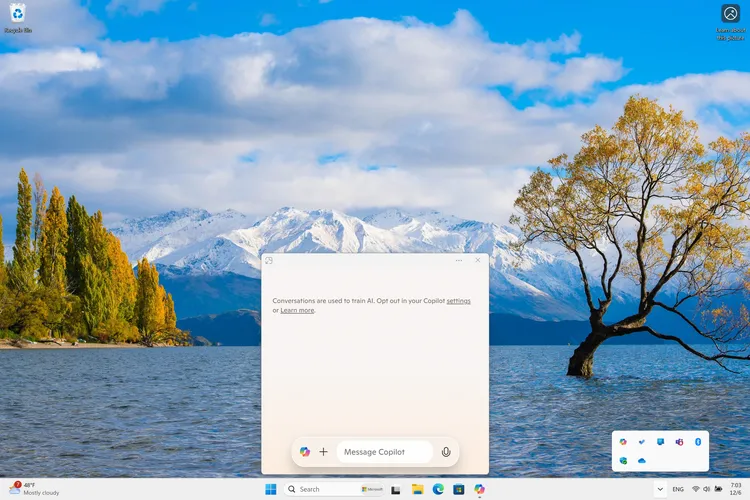Copilot gets a slightly more native experience on both Windows 10 and Windows 11.
Microsoft is once again refining how its Copilot AI assistant works on Windows, introducing notable updates that aim to enhance its usability and integration into the operating system. This latest iteration shifts Copilot from its previous Progressive Web App (PWA) format to a more “native” experience, bringing with it a fresh taskbar interface, a floating quick view, and a new keyboard shortcut. These updates are rolling out to Windows Insiders for testing and are set to redefine how users interact with the AI-powered assistant.
Floating Quick View: A New Taskbar Experience
One of the standout features of this update is the “quick view” UI for Copilot, which floats elegantly above the taskbar. This design resembles Microsoft’s new Companion apps currently in testing for managing files, contacts, and calendar entries. The quick view provides immediate access to Copilot and stays always on top of other apps until dismissed, making it a convenient tool for multitasking.
The quick view can be activated in two ways: using the newly introduced Alt + Space keyboard shortcut or through the system tray. While the feature itself doesn’t add groundbreaking new functionality, its always-on-top nature ensures Copilot remains easily accessible without interfering with ongoing tasks.

The Keyboard Shortcut Dilemma
The decision to assign the Alt + Space shortcut to Copilot has sparked some controversy. This shortcut is already in use by various apps, creating potential conflicts. Microsoft explains that whichever app—Copilot or another—is launched first and running in the background will take priority when the shortcut is pressed. This might lead to confusion or inconvenience for users relying on other applications that utilize the same combination.
The choice to move away from the Windows key + C shortcut previously used for Windows Copilot has also raised eyebrows. This older shortcut originated with Cortana and seemed a logical choice for consistency. Adding to the uncertainty, Microsoft has hinted that it is still exploring other keyboard shortcut options for Copilot, signaling that the AI assistant’s integration is still a work in progress.
A “Native” Copilot: What Does It Really Mean?
Copilot’s journey on Windows has been anything but linear. Initially introduced as a sidebar in Windows 11, the AI assistant was tightly integrated into the operating system, offering users a seamless experience. However, Microsoft later scaled back its functionality, reducing it to a basic web app for Copilot Plus PCs, which left many users underwhelmed.
Now, Microsoft claims the latest version is “native,” though it is essentially a web view wrapped in a slightly more integrated implementation. While not a fully standalone app, this design aims to balance functionality with performance, potentially laying the groundwork for future enhancements.
Windows 10 Compatibility: A Surprising Twist
In a surprising move, Microsoft is also extending this updated Copilot experience to Windows 10 users. This decision comes despite the company’s repeated insistence that Windows 10 will reach the end of support in October 2025. Earlier this year, Microsoft reopened beta testing for new Windows 10 features, citing its commitment to ensuring users get the most value from their existing PCs.
The inclusion of these features on Windows 10 demonstrates Microsoft’s strategy to cater to a broad user base while gradually encouraging upgrades to Windows 11. It also reflects the company’s acknowledgment that many users still rely on Windows 10 and would benefit from the added functionality Copilot provides.
The Evolution of Copilot on Windows
Microsoft’s Copilot has come a long way since its debut. Initially launched as Windows Copilot in 2022 as part of Windows 11, it was designed to appear as a sidebar accessible across all apps. However, the assistant’s evolution has been marked by shifts in strategy, including its demotion to a PWA and now its rebranding as a “native” app.
This latest update underscores Microsoft’s commitment to improving Copilot and ensuring it remains a valuable tool for users. By refining the interface, adding new accessibility features, and addressing user feedback, Microsoft is paving the way for a more cohesive and productive AI experience on Windows.
Looking Ahead
While the updates to Copilot are promising, they also highlight the challenges of integrating an AI assistant into a complex operating system like Windows. The keyboard shortcut conflict, the debate over what constitutes a “native” app, and the ongoing adjustments to functionality indicate that Microsoft is still fine-tuning its approach.
As these updates roll out to Windows Insiders, feedback will be crucial in shaping Copilot’s future. With the potential for further enhancements and a clear focus on user needs, Microsoft is positioning Copilot to be a central part of the Windows ecosystem. Whether these changes will resonate with users remains to be seen, but one thing is clear: Microsoft’s AI ambitions are far from over.










